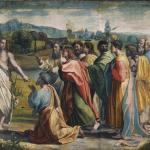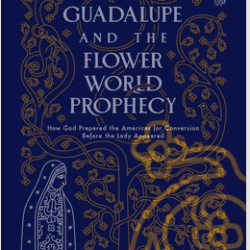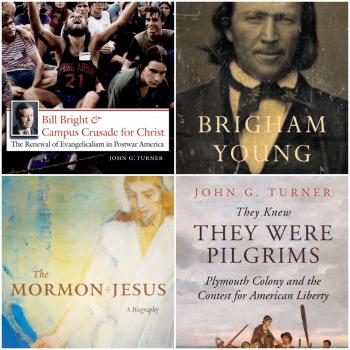“Having assumed the form of a woman,” a late second-century prophetess announced, “Christ came to me in a bright robe and put wisdom in me, and revealed to me that this place is holy, and that it is here that Jerusalem will descend from heaven.”
Epiphanius, a fourth-century bishop on Cyprus and categorizer of alleged heresies, attributed this oracle to Quintilla or Priscilla, key figures in the New Prophecy that arose in the latter half of the second century. Needless to say, Epiphanius was not a fan. He termed the recipient of this oracle a “deluded woman.” She had been asleep in Pepuza, a town in Phrygia, the center of the New Prophecy. According to Epiphanius (in the Panarion, a “medicine chest” against heresies), “Christ came to her and slept beside her in the following circumstances,” leading to the above revelation. According to Epiphanius, men and women are still initiated into the New Prophecy in Pepuza, with the promise that they will see Christ. Furthermore, honoring Eve’s eating from the tree of wisdom, the “Quintillianists” follow prophetesses and ordain women as bishops and presbyters. Epiphanius was confident that through his brief portrait and criticism, he had “squashed a toothless, witless serpent like a gecko.”
Tertullian, the prolific Carthage convert to Christianity deeply influenced by the New Prophecy, recorded several oracles of Priscilla. Otherwise, scholars are nearly entirely reliant on the writings of the prophets’ opponents for a reconstruction of their beliefs and activities. That has not stopped historians from reaching all sorts of conclusions about Montanism (as the New Prophecy became known to its opponents because of the role of a key prophet named Montanus). The above vision of Quintilla/Priscilla has been influential, leading many to conclude that the Montanists expected the New Jerusalem predicted in John’s apocalypse to descend from heaven and rest upon Pepuza (that is unclear from other sources).
Still, the New Prophecy is of unquestioned importance in any study of early Christianity. Its influence spread quickly, from Asia Minor to Rome and North Africa. Despite mounting opposition, it died out slowly, a slow disappearance over the course of many centuries rather than being squashed like a gecko.
As Laura Nasrallah explains in her An Ecstasy of Folly, many historians have portrayed the Montanists as a rearguard reaction against the institutionalization of Christian authority, as apostles increasingly relied on institutional authority as opposed to the charismatic authority of spiritual gifts. In this vein of thought, Christianity progressed from its ecstatic roots (dangerously close to primitive religions) to a more rational faith. The spirit declines over time. Nasrallah summarizes this point of view: “history progresses in such a way that human communities leave behind spirit and the ecstatic experiences it produces as they develop toward an ever-increasing rationality.”
In the view of their opponents, those attracted to the New Prophecy violated those standards. They were given to frenzy and strange utterances. They accepted the authority of dreams and visions. Worse, they claimed to speak for God. Epiphanius records that “this miserable little man Montanus says: ‘Neither angel nor envoy, but I the Lord God the Father have.”
The New Prophecy reminds us that we have to deal in a comprehensive fashion with visions, dreams, prophecy, and revelations. From the start, these topics posed fundamental questions for Christian believers (and their Jewish and other predecessors). How does God communicate with human beings? The Bible makes it clear that God has spoken to human beings in dreams and visions (often while the recipients of the visions were in some sort of trance-like state). Does God still speak with human beings that way?
These were never easy questions. The Roman philosopher Cicero once argued with his brother Quintus about dreams, visions, prophecies, and oracles. Quintus apparently believed that the gods frequently communicated with people through dreams, ecstatic trances, and forms of divinization. Cicero scoffed at this notion: “do the immortal gods, who are of surpassing excellence in all things, constantly flit about, not only the beds, but even the lowly pallets of the mortals, wherever they may be, and when they find someone snoring, throw at him dark and twisted visions, which scare him from his sleep and which he carries in the morning to a dream-expert to unravel?”
What was the line between divine ecstasy and madness? The Roman governor Festus told the Apostle Paul that he was “mad” (or insane) after the latter told of his Damascus-road vision. Greek culture praised self-control. Religious ecstasy (the root suggests standing outside oneself or outside of one’s mind) required a certain loss of self-control. Paul himself knew that both prophecy and speaking in tongues were potential dangers, leading to ecclesiastical confusion. He did not forbid or condemn their practice, but he did recommend greater gifts.
Prophets appear abundant in the very early decades of Christianity. John of Patmos was one of many. The Didache, perhaps written around the turn of the second century, warns against freeloading prophets who order meals while in the spirit. It seems there were not quite as many prophets by the time of Montanus, Maximilla, and Priscilla. “The New Prophecy,” writes Christine Trevett, “believed in the outpouring of the Spirit and the appearance of a new, authoritative prophecy which brought fresh disciplinary demands to the churches.” The early historian Eusebius (writing perhaps one hundred and fifty years after Montanus) denounced Montanus as one who “became beside himself, and being suddenly in a sort of frenzy and ecstasy, he raved, and began to babble and utter strange things, prophesying in a manner, contrary to the constant custom of the Church handed down by tradition from the beginning.”
Epiphanius was careful to distinguish between the sober, rational prophetic ecstasy and visions of the Old and New Testaments and the frenzied, irrational, insane utterances of the New Prophets. “The prophets fell into trances,” Epiphanius wrote, “but not into distraction.” Abraham “fell into ecstasy” but did not lose his wits. “[E]verything was said in truth by the prophets with sound mind and sober reason, and not in madness.” In contrast, Epiphanius claimed, the “Phrygians” (as the followers of the New Prophets were often known) were “not sound of mind and rational.”
Most Christians today are not familiar with the New Prophecy or Montanus. In a sense, though, Montanism has played a key role in the way that Christians for centuries have thought about prophecy, visions, and the outpouring of the Spirit. Again according to Epiphanius, the Phrygians instructed Christians that they needed to receive “the gifts of grace.” For some Christian leaders (such as Epiphanius), Montanism served as a warning against delusion, ecclesiastical chaos, and — for many — female leadership. For others, the Montanists were a more positive example, a brave struggle for primitive Christianity against oppressive leadership. John Wesley once commented that he “doubted whether that arch heretic, Montanus, was not one of the holiest men in the second century.” The Montanists, in Wesley’s formulation, were a remnant who still worshiped God “in spirit and in truth.” More recently, both feminist theologians and Pentecostal/charismatic Christians have seized on the New Prophecy as a positive example.
The irony of all such talk is that we hardly know enough about the New Prophecy — especially outside of Tertullian — to reach firm conclusions about its adherents’ millennial beliefs, their early relation to the “mainstream” church, and many other topics. What is clear is that the New Prophecy, often captured with the idea of a prophetess to whom Jesus Christ comes in the form of a woman, raised old questions which persisted long after the New Prophets themselves were forgotten.













